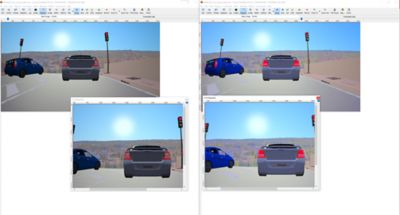Ansys博客
May 9, 2023
Ansys与Onsemi合作推动未来车辆感知能力的发展
仿真能够准确预测和验证各种驾驶环境中的传感器功能性。
我们可能很难想象这样一个世界:人类放弃驾驶控制权,让车辆来自行驾驶。但事实上,我们现在就能瞥见这样的未来。如今,道路上的许多车辆已经受益于高级驾驶辅助系统(ADAS),这些系统使用摄像头、雷达和激光雷达等传感器技术来避免与障碍物发生碰撞,帮助我们保持在车道内、进行平行泊车等。
所有这些系统都由人工智能(AI)传感进行指导,例如计算机视觉,它是自动驾驶汽车(AV)感知堆栈的核心功能。AV技术堆栈由多个功能层组成,包含特定的功能模块,负责自动驾驶所需的感知、连接、处理、分析和决策。与人类驾驶员非常相似,车辆的感知堆栈也会“环顾四周”,从车辆传感器收集数据,然后对数据进行处理,以了解目前的驾驶环境并对其做出响应。
作为自动驾驶领域的两大关键参与者,Ansys与onsemi合作提供独特的解决方案,以推进感知领域的发展,该解决方案包含了双方互补的技术,为原始设备制造商(OEM)和一级供应商提供了一个生态系统,以推动其开发和感知验证目标。
作为电源和传感技术领域的领导者,onsemi的目标是促进创新和开发智能技术,以解决复杂的客户挑战——包括车辆感知方面的挑战,从而支持AV的开发。与Ansys的合作使onsemi能够创建系统级仿真,以分析其开发决策的影响,并推动其技术进步。onsemi团队创建了传感器模型和虚拟数字孪生,然后使用Ansys AVxcelerate仿真来整合各种驾驶场景,从而将传感器模型转化为系统级仿真。
onsemi智能传感团队成像系统总监Shaheen Amanullah表示:“当我们能够预测和验证传感器在不同情况下的功能性时,onsemi传感器模型的价值就得到了提升。Ansys的仿真工具在实现这一目标的过程中发挥了至关重要的作用,它采用基于物理的方法生成场景,提供了我们所需的准确性。利用仿真技术,我们为展示、评估和开发新一代传感器奠定了基础,以满足客户不断变化的需求。此外,该平台还将帮助我们评估其对人眼视觉和机器视觉应用的影响。”

通过仿真建立传感器性能与真实世界的相关性
该情景下的价值主张是,使用性能非常接近实际传感器的模型,从而能够与真实世界建立相关性。这样,OEM厂商和一级供应商就可以利用此输出信息,满怀信心地评估自己的系统设计。AVxcelerate Sensors为onsemi传感器提供了基于物理的、适用于动态场景的多光谱光传播仿真,使其能够快速准确地测试和验证性能,而无需物理原型。
AVxcelerate Sensors使onsemi能够在产品定义和设计阶段,就对各种场景进行综合全面的验证。OEM厂商可以采用在AVxcelerate Sensors中经过验证的onsemi模型,进行感知算法测试,并立即确定需要改进的方面,再通过迭代更改进一步优化传感器,从而改进传感器开发流程。此外,通过这项工作,还能够探索感知算法的性能边界,并为算法训练提供领先优势。
联合成像器演示支持汽车摄像头测试
在2023年AutoSens Detroit展览会上,onsemi展位于5月9日至11日展示联合成像器演示。在本次演示中,Ansys和onsemi使用AVxcelerate Sensors创建了一个基本但关键的测试场景,用于验证ADAS/AV环境中的汽车摄像头性能。onsemi成像器模型基于AVxcelerate Sensors提供的信息,通过这一基本场景进行仿真,以更好地了解传感器设计对ADAS/AV系统的影响。然后,所有仿真结果都会与物理传感器实际录制的视频进行比对。

Hyperlux(右)系列具备保留闪烁光源的能力。没有出现上一代(左)传感器中出现过的伪影。
为了向客户提供可靠的解决方案,onsemi团队的目标是,实现实际传感器与仿真传感器在图像质量和传感器行为方面的高度相关性。为了量化最终仿真数据的准确性,采用了关键绩效指标(KPI)。在这种情况下,场景生成是实验的关键方面,因为它在实现与实际传感器的准确相关性方面发挥着至关重要的作用。
Ansys和onsemi致力于尽可能准确地再现基准场景,双方通力合作,以改进其工具并更好地满足关键要求。虚拟仿真还将帮助OEM厂商和一级供应商在早期阶段就与传感器制造商开展合作,从而基于由仿真支撑的数据定义新一代传感器,以更好地满足其要求。此外,他们可以将感知堆栈应用于仿真输出,相比于当前的做法,能够在流程中更早地开始训练其网络。
Amanullah表示:“目前,这些工作都是在传感器样品制作完成后才进行的,留给上市的时间窗口很短,从而限制了最终可实现的效果。通过“抢占先机”,OEM厂商和一级供应商将有更多时间来优化其算法和训练其网络,从而缩短样品制作流程后的验证阶段,并使其更加顺利。我们旨在改进当前的仿真方法,并在未来集成更多功能,以利用AVxcelerate Sensors为客户在不同场景中提供更准确的物理传感器表示。”